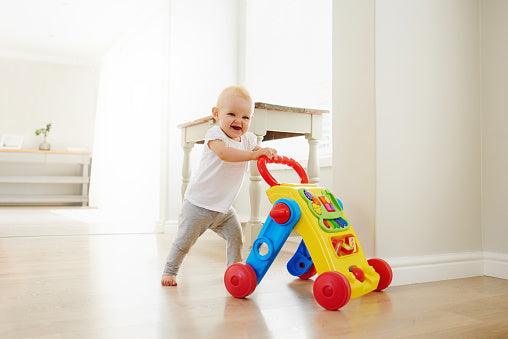Walking and standing are essential milestones that keep a baby healthy and on track for development.
A push walker can be fun and useful to help develop baby's walking skills but there are a few things to keep in mind. What type might work best for your home, and important safety considerations are a must before you buy a baby push walker. There’s a lot to consider when picking a push toy that works best for you, your baby and your home.
The best way to determine if your baby is ready to start standing is by checking their strength and rate of development; typically, if your baby/toddler is pulling him/herself up onto furniture then they’re ready for a push walker. The best baby push walker will help your baby develop the right skills, so they begin walking by themselves. Push walkers come in handy when babies start developing movement and walking skills.
BENEFITS OF A PUSH WALKER
Baby walkers tend to support walking and development in other ways as well. An activity walker is fun long before a baby can stand and walk and will encourage sitting and crawling which are both important developmental milestones. A push toy can be used much earlier than the walking stage. The thing is that a push toy can be used to promote floor play. Playing on the floor helps baby build skills in coordination and visual processing skills, as well as upper body and shoulder strength and stability. Playing with a walker toy as a baby has so many benefits in building core strength and the ability to push up onto hands and knees. When the older baby is sitting, a push walker makes a great toy because babies can move from various positions in sitting to prone as they manipulate toys.
BABY SIT TO STAND TO WALKING
The age range of 9-10 months, baby begins to explore their environment more and will demonstrate pulling up to a stand. This is the perfect time to incorporate a standing toy that incorporates play with sit to stand. A sit to stand toy like a push walker for baby offers the opportunity to pull up to a stand with a safe toy. Using a push along walker is a fantastic transition toy that allows baby to hold onto a walker handle and move from cruising on furniture to supported first steps.
What to look for in a baby walker
- How mobile is your baby? Some walkers may be more suited to babies who are just sitting up and pulling to stand. Others can cruise fast and are more fun for independent walkers.
- What type of flooring do you have? The weight and material of the walker you choose may work better on carpets, hardwood floors, tile, or if you have a mix of these floors in your home.
- Are you on the go a lot? Some walkers fold flat for easy transportation to a sitter’s house or on vacations. Others are bulky and easier to keep in the playroom.
- What is your budget? Walkers can range in price.
- What extras are you looking for? Some walkers are pretty simple, while others offer additional safety options, like rubber and locking wheels. Some walkers have lots of bright lights and music, while others are more muted and made from wood. It’s all a matter of personal preference.
- Can I use a hand-me-down? If it’s only a few years old, maybe. Otherwise, it’s a good idea to purchase your push walker new, as older models may be recalled or have other safety issues, like broken parts.
BABY WALKER SAFETY
Make sure the area where they’re walking around is babyproofed and free from hazards.
- Always make sure you are there to make sure the walker doesn't tip.
- EVen though push walkers are generally safer for your baby, you should never leave your baby to practice or play with it alone.
Sources:
- https://houseandbeyond.org/best-baby-push-walker
- https://www.theottoolbox.com/baby-push-walker-for-development/
- https://www.healthline.com/health/parenting/best-baby-walkers#what-to-look-for
Shop the Best Baby Walker and Push Toys at 4aKid.









